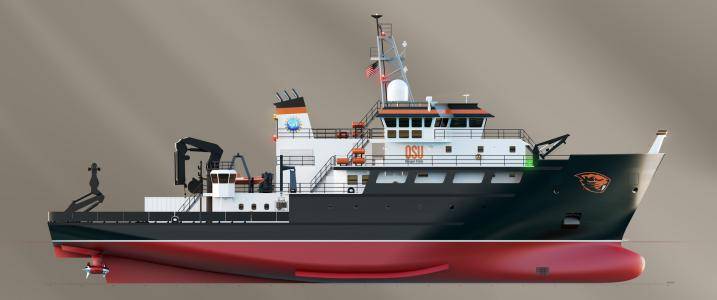Oregon State Seeks Shipyard Input for New Research Ship
Oregon State University to issue RFI on ship project after design completion
The design phase for a project to construct a new regional class research vessel to replenish the United States academic fleet is complete, and Oregon State University will issue a request for information (RFI) on Monday, May 2, to shipyards interested in constructing the vessel.
In January 2013, the National Science Foundation (NSF) selected Oregon State as the lead institution to finalize the design and coordinate the construction of the vessel – and possibly up to two more – a project considered crucial to maintaining the country’s marine science research capabilities.
The design phase has been completed by The Glosten Associates, a naval architecture firm based in Seattle, and the RFI is a chance to generate market interest and to get feedback from industry on the design and other project documents. OSU plans to issue a Request for Proposals (RFP) in two phases beginning this summer – a technical phase to establish a competitive pool of qualified shipyards and a cost phase to elicit vessel cost proposals.
“The Request for Information issued on May 2 is a chance for us to make final tweaks in the preliminary design and to open up a dialogue with industry about the project,” said Demian Bailey, Oregon State University’s former marine superintendent and a co-leader on the project. “Once we issue the RFP this summer, it will become more difficult to alter the design or other project documents.”
Although similar in size, the new ship will differ greatly from the R/V Oceanus, built in 1975 and operated by OSU, and its sister ships, Endeavor, operated by the University of Rhode Island, and Wecoma (retired), according to Clare Reimers, a professor in the College of Earth, Ocean, and Atmospheric Sciences and project co-leader.
“This class of ships will enable researchers to work much more efficiently at sea because of better handling and stability, more capacity for instrumentation and less noise,” Reimers said. “The design also has numerous ‘green’ features, including an optimized hull form, waste heat recovery, LED lighting, and variable speed power generation.”
These “regional class research vessels” are designed for studying coastal waters out to beyond the continental rise as part of the U.S. academic fleet that is available to all ocean scientists conducting federal and state-funded research and educational programs.
Among the design features:
- Each regional class research vessel will be 193 feet, with a range of 7,064 nautical miles;
- Cruising speed is 11 knots with a maximum speed of 13 knots;
- There are 16 berths for scientists and 13 for crew members;
- The ships can stay out at sea for 21 days before coming back to port.
- The 2017 President’s budget calls for building two RCRVs, but until a final budget is passed by Congress the plan is to make ready a shipyard contract to build one RCRV with options for additional vessels.
After reviewing the proposals from industry, OSU will select a shipyard in early 2017. The NSF will assume ownership of the regional class research vessels, but Oregon State expects to operate the first vessel constructed, which will conduct sciences missions primarily in the eastern North Pacific Ocean basin.
Additional vessels would be operated in the Atlantic and Gulf regions of the U.S. by other institutions that the NSF would select in late 2017.
“These ships will also have the ability to operate near ice and are considered ‘ice-classed,’ although they are not icebreakers,” Bailey said. The first ship will likely be delivered in 2020.


